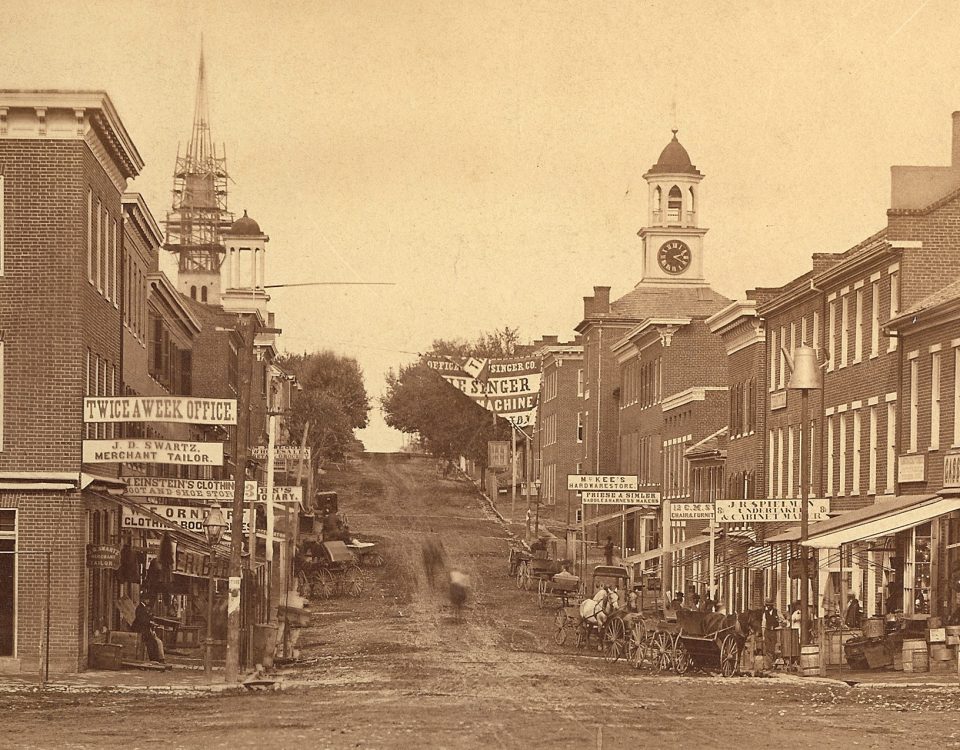Fantastic fossil finds in Washington County
Working for an organization that has been collecting artifacts for over 100 years sometimes feels like participating in a massive scavenger hunt. As the organization moved, so did those artifacts, sometimes losing records along the way. So sometimes I am lucky enough to come across complete collections that were previously unknown to us. One of these is our collection of local natural history specimens – especially, our fossils. After rediscovering some of our fossils a few years ago, we were offered the very special opportunity to have some identified by a Smithsonian expert. His identifications are what sparked the journey that would end in our ‘Fantastic Fossils’ exhibit that is now on display at the Miller House Museum.
At first glance, it does seem weird that a collection of fossils is on display in a Federal Period townhome, but there are multiple historical ties that make the exhibit a great fit with the house and our mission at the WCHS. Scientific experimentation made great strides during the Age of Enlightenment on a global scale, including here in America. Great minds and founding fathers Thomas Jefferson and Benjamin Franklin are still renowned for their scientific pursuits. The groundwork for modern paleontology was laid during this time period, and in fact, the first scientifically identified and categorized dinosaur fossil was discovered in England in 1824, a year before the townhouse was built here in America. So during the history of the house, fossil hunting and subsequent identification and display would have been a pursuit that was very much in vogue. In addition to fitting in well at the Federal Period museum, the fossils on display here at the Miller House Museum were actually all found within the borders of Washington County. They help to tell the story of the area prior to any written record, and it is a fascinating story to tell.
For most of its prehistory, Maryland was underwater, forming a part of what would become the Atlantic Ocean. Interestingly enough, at some point several hundred million years ago, the Appalachian Mountains formed and then were reabsorbed, before once again forming the current mountain chain. So the fossil record of Maryland, and especially Washington County, is extremely unique when compared to the rest of the United States. We don’t think of the area as having many dinosaurs, and for good reason – land dwelling creatures simply could not access the area for most of the time dinosaurs existed. However, the marine life that dwelled here over several hundred million years was both plentiful and diverse, and the resulting fossils reveal just how they may have looked.
500 million years ago, the sea level was much higher than it is today, and small creatures called arthropods ruled the world. Their modern day descendants are crustaceans, spiders, and insects, and the early arthropods shared the same general body shapes and exoskeletons. In the earliest fossils on display, you’ll find small creatures called trilobites. They look very similar in shape to horseshoe crabs, but these creatures went extinct 252 million years ago. Over the next few hundred million years, life evolved and expanded rapidly, with aquatic reptiles become more complex and eventually coming ashore to create the well-known dinosaurs. Mammalian life developed around 225 million years ago, but did not move back to the ocean until around 50 million years ago, resulting in our modern day whales and dolphins. The reason for this move was likely to avoid the competition for resources that emerged out of the end of the Eocene Epoch as a result of a mass extinction event. Major climate changes, possibly causing an ice age, and the major drop in sea levels, are just a few of the possible factors that scientists have proposed for the massive extinction event which occurred in this time period.
Once back in the ocean, whales and dolphins took advantage of the ample space and resources and grew – going from around the size of a Labrador to the size they are now in modern times. In the exhibit, you’ll be able to see for yourself just how rapidly the species diverged – both whale and porpoise vertebrae from approximately 50 million years ago are featured. Even at that point, the size difference is already noticeable. The reabsorption of the Appalachian Mountains meant that sea levels in Washington County were higher, allowing these large ocean-dwelling mammals to live here comfortably. Their reign over the area lasted until quite recently (prehistorically speaking, at least), until the Quaternary Period, approximately 2.5 million years ago. At this time, the Earth cooled down rapidly, leading to the formation of the Arctic ice cap. It’s during this time period that Maryland begins to emerge from under the sea, and Washington County was one of the first areas to appear. The steadily dropping sea levels meant that the waters were no longer home to large ocean dwellers, but small fish and shellfish could be found abundantly until the area fully emerged and dried out. The many clams, mussels, and other molluscs left their bony shells behind to form fossils, which can be found in abundance throughout the area to this day, some of them on display during the run of the new exhibit.
To learn even more about local fossils and see some of the wonderful natural history specimens that are a part of the WCHS collection, you can come see the ‘Fantastic Fossils’ exhibit. The museum is open to the public for self-guided tours from 10 – 4 Tuesday – Saturday, and the exhibit will run until March 31st. More information can be found at www.washcohistory.org or by calling 301-797-8782. Don’t miss it – it’s an exhibit that’s been 500 million years in the making!




















